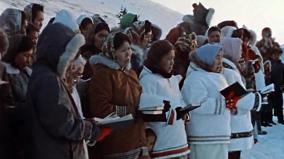New release
Coming
None
At the Caribou Crossing Place: Part 2
1967
29 min
Leaving soon
Filmed over a period of three years, from summer 1963 to the late winter of 1965, and released in 1967, the Netsilik series is about the traditional lifestyle of Netsilingmiut living in the area around Kuugaruk. In this episode, two men join the camp. The men build a row of inuksuit to deflect the oncoming caribou into the water, where they are harvested and floated ashore. A great feast follows.

Details
Filmed over a period of three years, from summer 1963 to the late winter of 1965, and released in 1967, the Netsilik series is about the traditional lifestyle of Netsilingmiut living in the area around Kuugaruk.
In this episode, two men join the camp. The men build a row of inuksuit to deflect the oncoming caribou into the water, where they are harvested and floated ashore. A great feast follows.
In this episode, two men join the camp. The men build a row of inuksuit to deflect the oncoming caribou into the water, where they are harvested and floated ashore. A great feast follows.
-
directorQuentin Brown
-
producerQuentin Brown
-
executive producerKevin Smith
-
consultantAsen BalikciGuy Mary-Rousselière
-
cameraRichard BergmanKen CampbellKen PostDouglas WilkinsonRobert Young
-
soundJacques Drouin
-
editingElvin CariniMichel ChalifourWilliam GaddisJack HirschfieldBill Tannebring
-
sound editingMalca GillsonKen PageDon Wellington
-
re-recordingRon AlexanderRoger Lamoureux

















